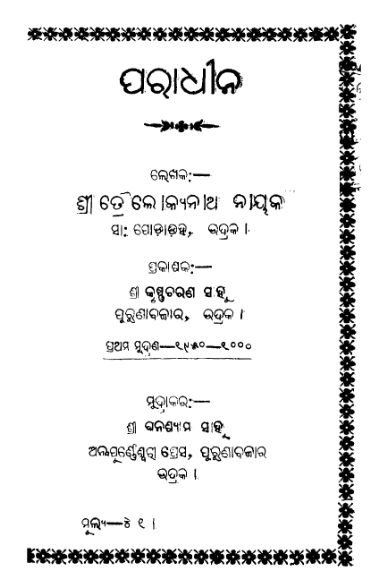Paradhina, written by Trailokya Natha Naik and published in 1950, stands as a significant work in the landscape of Odia literature, particularly within the genre of drama. This play is a thoughtful exploration of human emotions, societal dilemmas, and the constant struggle for identity and freedom. Naik, a prominent playwright of his time, masterfully weaves complex characters and compelling narratives that resonate with audiences even today.
At its heart, Paradhina delves into the lives of individuals grappling with the concept of captivity—both literal and metaphorical. The title itself, meaning The Enslaved, sets the tone for a narrative rich in tension and conflict. The characters navigate their relationships and societal expectations, revealing the profound ways in which external circumstances dictate personal choices and moral values.
The protagonist is portrayed as a quintessential figure who embodies the ideals of resilience and perseverance. Faced with various pressures from society, family, and the oppressive structures within which they exist, the character’s journey evokes a sense of empathy from the audience. Naik skillfully captures the nuances of human emotions, allowing readers and viewers to connect deeply with the struggles faced by the characters.
One of the core themes in Paradhina is the quest for freedom—not just from physical bondage but also from societal norms and internal conflicts. The play serves as a commentary on the caste system, gender roles, and the socio-political constraints that bind individuals. Naik’s characters often find themselves questioning their identities and the roles assigned to them by society. This exploration of self-discovery is a recurring motif that resonates powerfully, making the “Paradhina” relevant across different generations.
The duality of captivity—externally imposed and self-inflicted—invites the audience to reflect on their own lives. The struggles depicted in the play challenge viewers to think critically about the nature of freedom and the sacrifices often demanded to obtain it. Naik’s portrayal of these themes encourages a more profound understanding of the internal battles that many face in their pursuit of personal liberation.
Naik employs various dramatic techniques that enhance the overall impact of Paradhina. The dialogue is sharp, filled with emotional depth and philosophical inquiries that push the characters toward self-examination. The use of symbolism throughout the play adds layers of meaning, allowing for multiple interpretations and encouraging discussions among audiences.
Moreover, the stage directions and the physicality of the performances are instrumental in conveying the emotional weight of the characters’ journeys. Naik’s understanding of how to utilize space and movement dynamically elevates the play’s emotional stakes, making each scene resonant and impactful.
Books Info
| Books name | Paradhina / ପରାଧୀନ |
| Author | Trailokya Natha Naik |
| No Of pages | 109 |
| Publisher | Sri Krushnacharan Sahu |
| Publication | 1950 |
| Printed At | Sri Ghanashyama Sahu |
| Distributor | NA |

